Big Finish For Chico State’s Tiny House
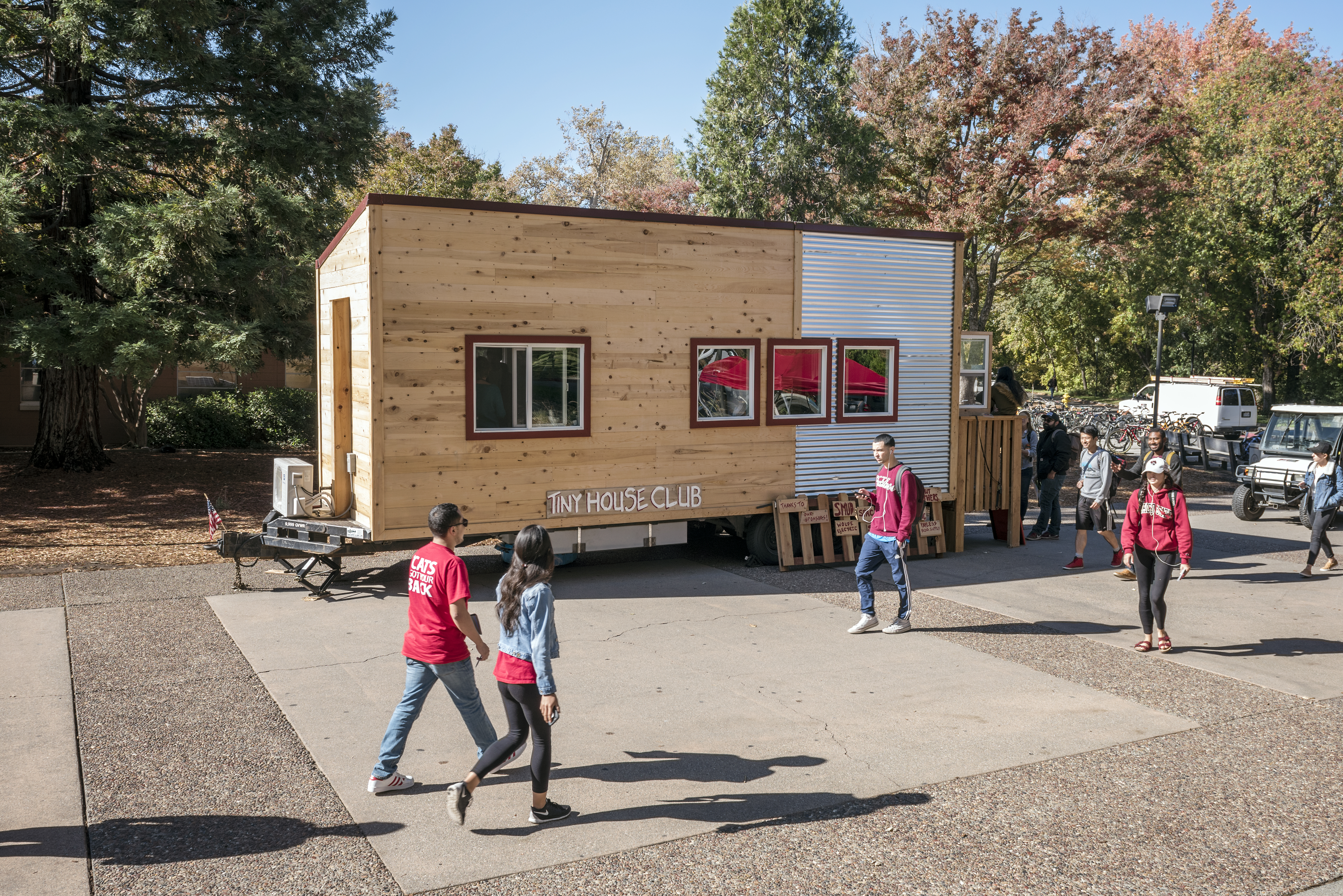
The Chico State Tiny House Club gave a tour of their 196 sq. ft tiny house to the campus on Wednesday, October 26, 2016 in Chico, Calif. (Jason Halley/University Photographer)
Back in October 2014, Joe Dell’Osso and Blake Bergh had audacious plans to build something small. These two longtime friends and California State University, Chico students sought to design and build a tiny, self-sustaining house with zero carbon footprint measuring between 100 and 400 square feet, and enter it into a first-of-its-kind competition at Sacramento Municipal Utility District’s (SMUD) Tiny House Competition at Cosumnes River College in October 2016.
The idea behind the competition was to employ net zero energy and eco-friendly building techniques, and promote sustainable living. Teams were judged in the major categories of architecture, communications, energy, and home life.
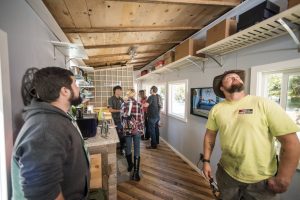
(Jason Halley/University Photographer)
This challenge appealed to Dell’Osso (BS, Construction Management, ’16) and Bergh (BS, Civil Engineering, ’16), and, together with about a dozen students, they created the Chico State Tiny House Club. This was a true interdisciplinary project (with students representing civil engineering, mechanical engineering, mechatronic engineering, construction management, communications, and political science), something Tiny House Club mentor David Alexander said was incredibly valuable.
As the team leaders, Dell’Osso and Bergh worked on a design, and by September 2015, the student-run club had one completed. The tiny house would take up all of 196 square feet.
There was just one problem.
“We had no funding,” said the club’s current president Tim Wion. But the group did have an agricultural trailer and a bit of stipend money from SMUD with which to start.
With work being done on the tiny house at the University Farm, the club tabled for support on campus and at University events. Little by little, the club raised funds, enough to do occasional work until they ran out of money again. Alexander said that Dell’Osso and Bergh were instrumental in securing funding and sponsors, reaching out to local businesses for equipment and supplies, including Payless Building Supply, which donated plywood and the agricultural trailer.
By the end of December 2015, the trailer had four walls, but no roof.
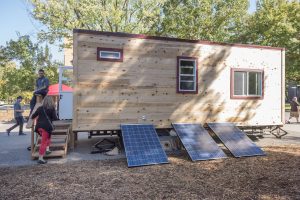
(Jason Halley/University Photographer)
Bergh applied for a grant from Chico State’s Sustainability Fund Allocation Committee (SFAC). Fletcher Alexander, member of SFAC, said the Tiny House Club delivered on SFAC’s criteria for its choices—including innovation, sustainability, and breadth of impact. “This was truly an original idea and one that hadn’t been brought to the committee before,” Fletcher Alexander said.
Once the Tiny House Club received a $15,000 grant from SFAC, “That was the final, ‘OK, I guess we’ll to have to finish this house now’,” Wion recalled.
Dell’Osso and Bergh both graduated in December 2015, and with the table set, Wion became the new club president and the group went to work, siding the trailer and putting in windows and a roof. In March 2016, the team moved the house to the Chico State campus, where interior work began: flooring, cabinets, framing the bathroom and walls, and electrical wiring.
Finally, the things that make a tiny house a home were added: repurposed flooring; a Murphy bed; a 15-gallon water heater; six roof solar panels, with three auxiliary and moveable ground solar panels outside; a battery that lasts a day and a half; a fully functional bathroom with shower, sink, and toilet; kitchen cabinets and a sink; and a working washing machine beneath the kitchen counter.
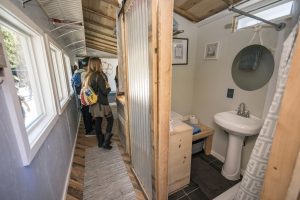
(Jason Halley/University Photographer)
Last month, Chico State finally took its product to the Tiny House Competition in Sacramento to see where it stacked up against tiny houses from eight other schools. “Eighteen schools started out in the competition, nine of them realized how hard it was and dropped out, and nine of us showed up,” Wion said.
Judging took place over three days in October, and though it didn’t win in any of the major categories, Chico State impressed the judges enough to earn top honors in Advanced Controls, Best Flooring, and Best Home Technology. (Silicon Valley’s Santa Clara University took the top prize.)
SMUD’s Suzette Bienvenue (BA, Psychology, ’80; BS, Biology, ’80) said everyone at SMUD couldn’t help but be impressed by the Chico State team.
“They did a beautiful job of understanding the electronic controls and explaining it to the judges,” said Bienvenue. “Aesthetically, I really like what they did by camouflaging the controls in the kitchen area with simple wood lattice work from which they hung utensils and pots. The flooring was carefully and meticulously planned, repurposing the original wood that was on the base of the trailer.”
On Oct. 15, the schools displayed their tiny homes for the public. SMUD expected 3,000 people to show up. Bienvenue said they lost count after reaching 11,000 people—at noon.
“I expected niche groups, like millennials, retirees, survivalists, architects, and others,” she said. “The attendees were a slice of America, with all age groups, ethnicities, etc. And, since the Kid Zone was slammed, apparently a lot of families attended, as well.”
Two years after Dell’Osso and Bergh were invited to enter the competition, Wion and the rest of the Chico State Tiny House Club finished the job. This truly was a student-run project, with the design and building done by students on their own time.
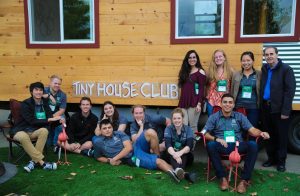
“The other schools, even though they had students work, they have classes and get units for this, they had dedicated time, money, and resources to do this,” club member Andrew Bautista said. “We had to go out and find all of that, do all of that, do it on our own time when we weren’t busy between classes. The amount of work that the whole club put in was something that I found pretty respectable and very admirable.”
“If we had a Scrappy Award, it would have gone to Chico State,” Bienvenue said. “They made do with what they had, they made it work, and made it functional and interesting, and all with a great attitude.”
So what happens to the tiny house now? Instead of retiring the tiny house to rot away in obscurity, Chico State has donated the house to Habitat For Humanity, which will use it as the model home unit in a planned tiny house community in Yuba City. Chico State’s tiny house will make the trip later this month.


